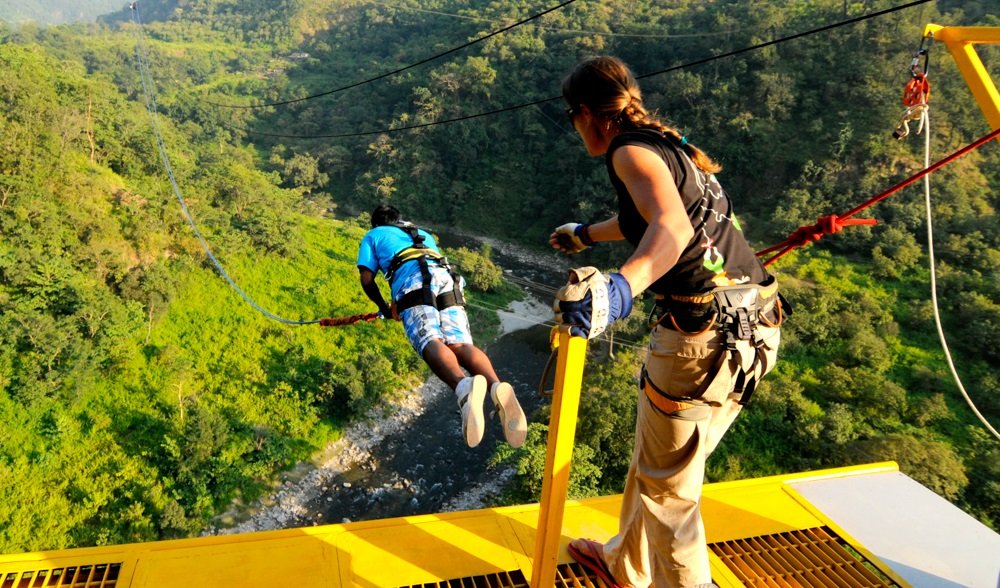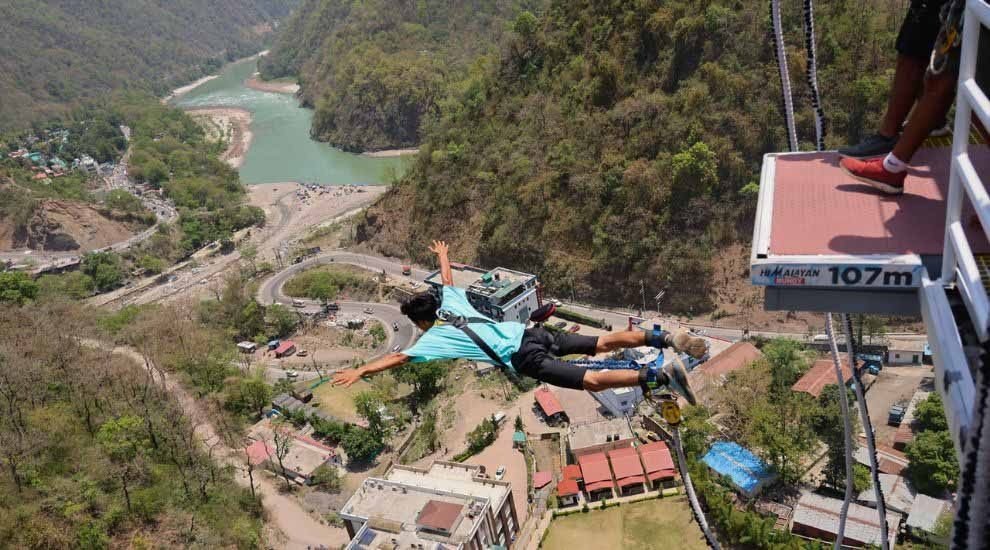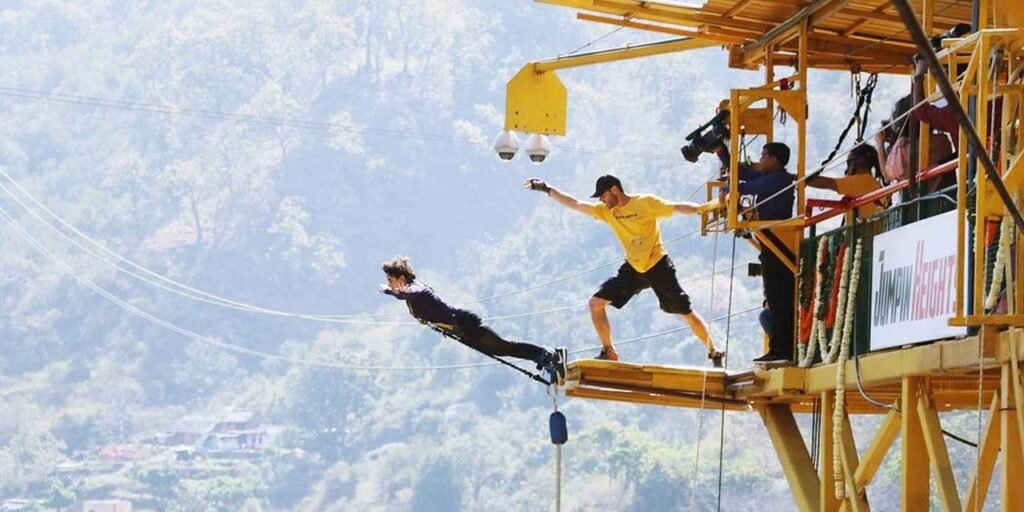Bungee jumping is one of the most exhilarating and heart-pounding adventures you can experience. Whether you’re an adrenaline junkie or simply seeking a new way to conquer your fears, this extreme sport promises a rush like no other. But bungee jumping is not just about the thrill—it’s a journey of self-discovery, overcoming challenges, and facing the unknown.
In this blog, we will dive deep into the history, safety precautions, cultural significance, and why so many people find themselves drawn to the edge of a platform, ready to take the leap. If you’ve ever wondered what it’s like to bungee jump, this guide will provide all the answers you need.
The History of Bungee Jumping in rishikesh
The roots of bungee jumping trace back to ancient traditions, with one of the earliest known occurrences being the “land diving” rituals of the people of Pentecost Island in Vanuatu. Men would jump off wooden towers, with vines tied around their ankles, to demonstrate their bravery and prove their manhood. The idea was that the jump symbolized a rite of passage and connection with the gods, with the vine stretching to create a thrilling freefall. This practice can be considered the earliest form of bungee jumping in rishikesh.
In the modern world, however, bungee jumping in rishikesh took a more commercial turn in the 1980s. The sport was popularized by a group of thrill-seekers from New Zealand, led by AJ Hackett. Hackett, inspired by the land diving tradition, adapted the technique by using an elastic cord instead of vines, making the jumps safer and more controllable.
In 1986, Hackett became a pioneer in the field by performing the first commercial bungee jump off the Auckland Harbour Bridge. This jump sparked the growth of the sport, with bungee jumping in rishikesh locations popping up all over the globe.
Today, bungee jumping is an international adventure sport, with countless companies offering jumps at various scenic locations worldwide.

The Science Behind Bungee Jumping
What makes bungee jumping in rishikesh so thrilling? The answer lies in physics. When a person leaps off a platform, gravity pulls them toward the ground at increasing speeds. However, the bungee cord, which is elastic, starts to stretch as the person falls, slowing the descent. The cord then recoils, and the jumper is pulled upward again. This results in a series of bounces before the jumper comes to a gentle stop.
The science of bungee jumping in rishikesh involves two primary forces: gravity and the tension of the bungee cord. Gravity acts to pull the jumper downward, while the tension in the cord counteracts this force. The elasticity of the cord allows it to stretch and absorb the jumper’s kinetic energy, making the fall feel like a controlled freefall, and providing the thrill of weightlessness.
However, as the cord reaches its maximum extension, it begins to recoil, bringing the person back upward.
The thrill and danger of bungee jumping come from the jump itself—the experience of free-falling for several seconds—and the fact that the cord must be precisely calibrated to ensure the jumper’s safety. If the cord is too long or too short, it could result in serious injury or even death. Fortunately, safety precautions and professional oversight have made the sport incredibly safe, despite its intense nature.
Safety Measures and Precautions
Despite its adrenaline-packed nature, bungee jumping in rishikesh is an incredibly safe sport when carried out under the right conditions. There are strict regulations, well-established protocols, and advanced technology to ensure the safety of participants. Here’s a breakdown of the essential safety measures you can expect when bungee jumping:
1. Quality Equipment
The bungee cord itself is the most important piece of equipment. It must be made of high-quality, durable elastic material designed to withstand immense tension. Modern bungee cords are typically made of latex, and they’re often designed to be multiple times stronger than the force they are likely to experience during a jump.
The harnesses and ropes used to secure the jumper are also built to ensure that the weight distribution is even, and no part of the body experiences excessive pressure during the fall.
2. Pre-Jump Checks
Before you even step onto the platform, professionals will conduct several safety checks. First, the bungee cord’s elasticity is carefully matched to your weight, ensuring that the jump will be smooth and controlled. Secondly, the harness you’ll wear will be tightly secured, typically around your ankles and waist.
You’ll undergo a thorough briefing about the jump, the experience, and what you need to do to ensure your safety. This includes instructions on how to position your body and how to behave during the fall.

3. Experienced Staff
Safety cannot be guaranteed without experienced staff members who are well-trained in handling the technical aspects of bungee jumping. Professionals are responsible for ensuring that the equipment is set up correctly, and they also supervise the jump to ensure that everything goes as planned.
These staff members are highly trained in emergency procedures and risk management, with many companies offering certifications for their staff to demonstrate their competence.
4. Location Safety Standards
When you visit a reputable bungee jumping in rishikesh company, the location is likely to meet all relevant safety standards. This includes inspecting the platform, ensuring it’s secure, and that there’s proper infrastructure. The jump zones are also often monitored for any changes in weather conditions, such as high winds or storms, which could affect the safety of the jump.
5. Health Considerations
Before you take the leap, you’ll likely be asked about any medical conditions you have. Those with heart conditions, high blood pressure, or certain other health issues may be advised against jumping. If you’re unsure about your health status, it’s always a good idea to consult a doctor before attempting a bungee jump.
The Mental and Physical Benefits of Bungee Jumping
While bungee jumping in rishikesh is often associated with the rush of adrenaline, it offers more than just a thrilling experience. The act of taking the leap is an exercise in overcoming fear, boosting confidence, and achieving a sense of personal accomplishment.
1. Overcoming Fear
One of the primary reasons people choose to bungee jump is to confront their fears head-on. Many people experience an initial hesitation or fear of jumping from great heights. However, once you take the leap, you often experience a sense of relief and triumph, having pushed past a mental block.
The fear you feel in the moments before the jump is replaced with feelings of empowerment and accomplishment once you’ve taken the plunge.
2. Confidence Boost
Successfully completing a bungee jump can be incredibly empowering. It takes courage to step off the platform and trust in the safety mechanisms that will catch you. When you land safely at the bottom, you gain confidence in your own ability to take on challenges and overcome obstacles.
3. Endorphins and the “Rush”
Bungee jumping in rishikesh triggers a flood of endorphins, which are the body’s natural “feel-good” chemicals. As a result, many jumpers report experiencing a euphoric sensation during and after the jump. This release of endorphins contributes to the rush of adrenaline that gives bungee jumping its addictive quality. The feeling of weightlessness and the rush of air as you fall can create a sense of freedom, and many people find that they are hooked on the experience, seeking to jump again.
4. Stress Relief
Adrenaline activities like bungee jumping are also known to release pent-up stress. The intense focus required during the jump helps to clear your mind, and once you’ve completed the jump, many people report feeling a sense of peace and relief, as though a weight has been lifted off their shoulders.

Why Do People Bungee Jump?
So, why do so many people find themselves standing on the edge of a platform, looking down at what seems like an insurmountable drop, only to leap into the unknown? There are several reasons why bungee jumping has become such a popular activity:
1. Thrill Seeking
For many, the primary reason to bungee jump is the sheer thrill of the experience. There is nothing quite like the sensation of free-fall, and the adrenaline rush that accompanies it. It’s the ultimate test of bravery and provides an unmatched rush for those seeking excitement.
2. Conquering Fear
Some people see bungee jumping as a way to face their fears. Stepping out of your comfort zone and pushing past your anxieties can help boost your mental resilience. The experience of overcoming fear can be highly empowering, giving you the courage to face other challenges in life.
3. Sharing an Experience
Bungee jumping is often done in groups, with friends or family joining in the thrill. Many people enjoy sharing this once-in-a-lifetime experience with others. The communal aspect of the activity, combined with the shared excitement, makes the event even more memorable.
4. Bucket List Adventure
For many, bungee jumping is something they’ve always wanted to try. It’s one of the items that frequently appears on people’s bucket lists. Whether you’re planning a once-in-a-lifetime adventure or celebrating a milestone, bungee jumping is an unforgettable way to make memories.
The Future of Bungee Jumping
As bungee jumping continues to grow in popularity, the future of the sport looks bright. We can expect to see even more innovative ways to experience the thrill, from jumps in increasingly unique locations (such as skyscrapers or over rivers) to new technology that will make the jumps even safer and more exciting.
Bungee jumping is also making its way into the world of virtual reality. Some companies are beginning to offer VR bungee jump experiences, where participants can simulate the thrill of jumping from a high platform without actually making the physical jump. While this offers a less intense version of the experience, it is an exciting glimpse into how technology and adventure can come together.
